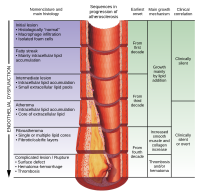
Photo from wikipedia
BACKGROUND Patients with ischemic stroke are vulnerable to heart failure with preserved ejection fraction (HFpEF) because these conditions share common risk factors. Although evaluation of the ascending aorta, aortic arch,… Click to show full abstract
BACKGROUND Patients with ischemic stroke are vulnerable to heart failure with preserved ejection fraction (HFpEF) because these conditions share common risk factors. Although evaluation of the ascending aorta, aortic arch, and proximal descending thoracic aorta is an essential step to determine the source of the causative embolism, the relationship between the degree of aortic atheroma and left ventricular (LV) diastolic function has not been extensively investigated. METHODS We analyzed the transesophageal and transthoracic echocardiography in ischemic stroke patients. Patients with previous coronary artery disease, valvular heart disease of more than moderate degree, and an LV ejection fraction of less than 50% were excluded. The relationships between the grade of the aortic atheroma, aortic stiffness indexes, and diastolic functional indexes were evaluated. RESULTS In 295 patients, the atheroma grade was significantly correlated with aortic stiffness index, ratio of mitral annular and inflow velocities (E/e'), left atrial volume index, and LV diastolic elastance. With further adjustment for age, hypertension, diabetes, estimated glomerular filtration rate, left atrial volume index, and LV mass index, the significance of the atheroma grade was attenuated. In the subgroup analysis, the atheroma grade was significantly and independently related to E/e' in women (β = 0.181, p = 0.032), but not in men. However, atheroma grade was not associated with poor clinical outcomes in either sex. CONCLUSIONS Aortic atheroma grade was significantly and independently related to LV diastolic function, especially in women. This suggests that aortic atheroma is an index of arterial stiffness and a potential risk factor for HFpEF through ventricular-vascular interactions, especially in women.
Journal Title: Reviews in cardiovascular medicine
Year Published: 2022
Link to full text (if available)
Share on Social Media: Sign Up to like & get
recommendations!